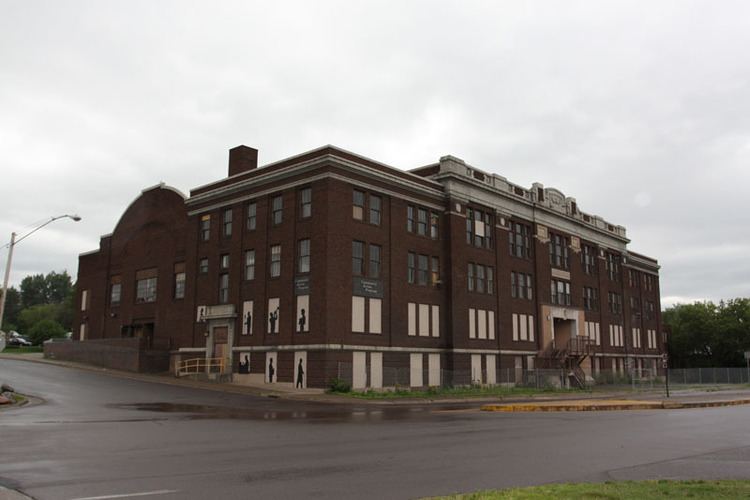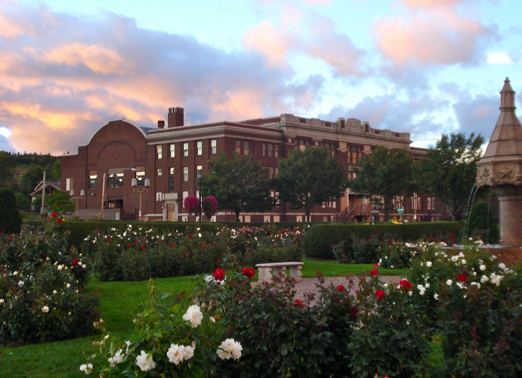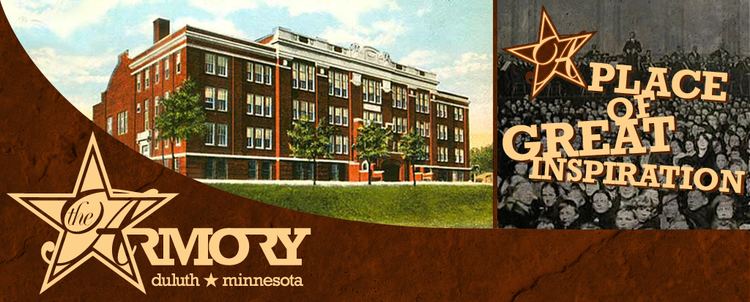Built 1915 Opened 1915 | NRHP Reference # 11000324 Added to NRHP 1 June 2011 | |
 | ||
Architect Original building:Clyde W. KellyOwen J. Williams1941 addition:Phillip C. Bettenburg Similar Leif Erikson Park, Spirit Mountain, Duluth Entertainment Conventi, Aerial Lift Bridge, Riverside Ballroom | ||
Duluth armory video
The Duluth Armory, also known as the Duluth National Guard Armory, is a historic building in Duluth, Minnesota, listed on the National Register of Historic Places. The armory was built in 1915 to replace the previous one, built in 1896, which had become inadequate. In 1978, it was purchased by the city and its use as an armory was discontinued. Since 2000, the armory has been threatened with demolition, though efforts are ongoing to renovate the building.
Contents
- Duluth armory video
- Google fiber the duluth armory
- Planning and construction
- Later history
- Architecture and use
- References
Google fiber the duluth armory
Planning and construction

A prior armory was built in Duluth in 1896 for the Minnesota National Guard. In 1899, Minnesota created a naval reserve, introducing a two-division unit in Duluth. The addition strained the available space in the armory. Attempts were made to use some of the first floor, but this conflicted with existing commercial activity.

In September 1913, the city of Duluth announced that it would deed property for a new armory, to be located at the end East Thirteenth Avenue along the waterfront. The proposed location was opposed by some residents; the property was in Lake Shore Park, which had been donated to the city by the Saint Paul and Duluth Railroad under the condition than it remain parkland in perpetuity. The city argued that it was the optimal location and the building would not negatively impact the park. An article in the Duluth News Tribune, published a few days later, showed a site plan and argued that the new armory would "only occupy a corner of the park."

Planning proceeded slowly, despite the urgent need for more spacious facilities. By November 1914, the planned building site had moved across London Road, apparently heeding earlier protests; the new location had previously been purchased by the city for $16,000. The state of Minnesota allocated $112,500 for the armory, and after some delay, bidding began in February 1915. The contract was earned by George H. Lounsberry of Duluth. The building, estimated to cost $107,410, was designed by architects Clyde W. Kelly and Owen J. Williams. The project came in over budget at $150,000; $103,000 was paid by the state, $18,500 by the city, and the remainder by "public-spirited" citizens. The new armory held its grand opening on November 22, 1915. The celebration was attended by Governor Winfield S. Hammond, former governor Adolph Eberhart, and other officials.
Later history

In September 1940, an expansion of the armory was announced by Sidney L. Stolte of the Work Projects Administration. Plans drafted by architect Phillip C. Bettenburg in November 1940 featured an expanded stage, classrooms, a kitchen, and restrooms. The addition was a brick, multi-story structure along the northern side of the armory, designed with a flat roof to accommodate a fly loft for the stage. Work on the addition, which cost $95,896, began mid-April 1941 and continued into winter.

On January 31, 1959, Buddy Holly performed at the armory; he died in a plane crash days later on February 3. Bob Dylan attended the performance, which he cited as an inspiration at the 1998 Grammy Awards when he received Album of the Year for Time out of Mind. He said,
I just want to say that when I was 16 or 17 years old, I went to see Buddy Holly play at Duluth National Guard Armory and I was three feet away from him… and he looked at me. And I just have some kind of feeling that he was – I don’t know how or why – but I know he was with us all the time we were making this record in some kind of way.
The value of the armory as a public venue greatly decreased with the construction of the Duluth Arena-Auditorium in 1966, which had more seating and modern amenities. In 1977, the National Guard announced plans to build a new armory in Duluth and in 1978, the city purchased the historic armory from the state for $160,000. The Head House was used for offices and the Drill Hall served as a garage for maintenance vehicles. The Drill Hall also stored some raw materials, and its original wood floor no longer exists.
In 2000, the armory was first threatened with demolition, but the city made efforts to study the cost of repairing the building for reuse. A Duluth Planning Department report from April 2002 estimated it would cost $235,000 to abate asbestos and $1.3 million to abate lead from its time as a shooting range. On May 24, 2004, the building was purchased by the Armory Arts and Music Center for $1.
The armory was nominated for inclusion on the National Register of Historic Places under Criterion A for statewide military significance and local significance in entertainment and recreation. The building was listed on the National Register on June 1, 2011.
The armory was damaged by flooding in June 2012 from Chester Creek, which runs beneath the building. The creek breached its culvert, creating a "significant sized hole" in the basement allowing water to enter, which damaged electrical systems, disturbed asbestos, and led to an accumulation of debris and sediment within the building. Because the city owns the culvert, it paid for repairing the flood damage. A six-month stay from demolition was granted by the city in August 2012 because restoration was progressing. In April 2013, heavy snow damaged a parapet on the Drill Hall, causing a number of bricks to fall to the ground.
Architecture and use
The armory is located in the East Hillside neighborhood. It fronts London Road, and across the street is Leif Erickson Park. The building consists of three main parts—the Head House, the Drill Hall, and an addition built in 1941. The exterior walls are variegated dark brown brick.
The Drill Hall is 190 feet 8 inches (58.12 m) long and 93 feet (28 m) wide. Within Minnesota, at the time of construction, the size of the armory's Drill Hall was second only to the 1907 armory in Minneapolis, and the Duluth Armory as a whole was larger than the one in Minneapolis. The Drill Hall served as a venue for expositions, trade shows, musical groups, and recreational and sporting events.
The Head House contained administrative offices, classrooms, and service areas. It is 200 feet 2 inches (61.01 m) long by 34 feet (10 m) wide and is 69 feet (21 m) tall.
The 1941 addition is 154 feet 8 inches (47.14 m) long and 45 feet (14 m) wide, extending 11 feet 4 inches (3.45 m) beyond the rear wall of the Drill Hall.
